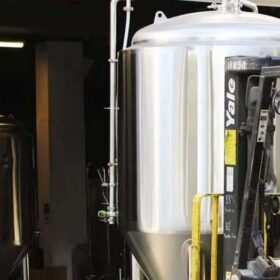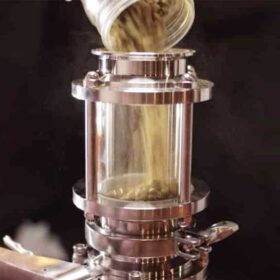Fermentation is a fascinating process that transforms raw ingredients into delicious foods and beverages through the action of microorganisms. To ensure a successful fermentation, one crucial element is the fermentation vessel. In this article, we will explore the different types of fermentation vessels, the factors to consider when choosing one, the benefits they offer, the steps for fermenting in them, and how to overcome common challenges. So let’s dive in and discover how these vessels play a vital role in the art of fermentation.
Introduction to Fermentation Vessels
Fermentation vessels are containers designed to provide an optimal environment for the fermentation process. They come in various shapes, sizes, and materials, each with its own set of advantages and considerations. The primary purpose of a fermentation vessel is to create a controlled environment that promotes the growth of desired microorganisms while preventing the intrusion of unwanted contaminants.
Types of Fermentation Vessels
1. Open Fermentation Vessels
Open fermentation vessels, as the name suggests, are containers that are left uncovered or partially covered during the fermentation process. They allow for natural airflow and exposure to ambient microorganisms. This type of vessel is commonly used in traditional fermentation practices, such as brewing and winemaking, where specific strains of wild yeast and bacteria are desired.
2. Closed Fermentation Vessels
Closed fermentation vessels, on the other hand, are sealed containers that provide a more controlled and isolated fermentation environment. They are often equipped with airlocks or valves that allow gases produced during fermentation to escape while preventing the entry of air and contaminants. Closed vessels are commonly used in modern brewing, wine production, and other fermentation processes where precise control over the fermentation conditions is essential.
3. Stainless Steel Fermentation Vessels
Stainless steel fermentation vessels are popular in commercial settings due to their durability, hygiene, and ease of cleaning. They are resistant to corrosion, provide excellent temperature control, and offer a neutral environment that does not react with the fermenting liquid. Stainless steel vessels are commonly used in brewing, wine production, and fermentation of various beverages and foods.
4. Glass Fermentation Vessels
Glass fermentation vessels are favored by home fermenters and small-scale producers. They are visually appealing, allowing for easy monitoring of the fermentation process. Glass is non-reactive and does not introduce any unwanted flavors or odors to the final product. However, glass vessels may be more fragile and require careful handling to prevent breakage.
5. Wooden Fermentation Vessels
Wooden fermentation vessels, such as oak barrels, have been used for centuries in the production of wine, beer, and spirits. Wood imparts unique flavors and aromas to the fermenting liquid, contributing to the complexity of the final product. These vessels require regular maintenance, including sealing and periodic reconditioning, to prevent leakage and microbial contamination.
6. Plastic Fermentation Vessels
Plastic fermentation vessels, made from food-grade materials like HDPE (high-density polyethylene), are affordable and lightweight options. They are commonly used by homebrewers and beginners in fermentation. Plastic vessels are easy to clean, but they may retain odors over time and may not provide the same level of temperature stability as other materials.
7. Ceramic Fermentation Vessels
Ceramic fermentation vessels have a long history in traditional fermentation practices. They offer good insulation and breathability, allowing for gradual temperature changes during fermentation. Ceramic vessels are ideal for fermenting certain foods like kimchi, sauerkraut, and miso. However, they require careful handling to avoid breakage and may be more challenging to clean thoroughly.

Factors to Consider when Choosing a Fermentation Vessel
When embarking on a fermentation journey, selecting the right fermentation vessel is crucial for a successful and enjoyable process. Several factors should be taken into account when choosing a fermentation vessel:
1. Temperature Control
Different fermentation processes require specific temperature ranges to promote the growth of desired microorganisms. It is important to consider a vessel that allows for easy temperature control. Some vessels come with built-in temperature control systems, while others may require external methods such as water baths or temperature-controlled rooms. Ensure that the chosen vessel offers the necessary temperature regulation capabilities to maintain optimal fermentation conditions.
2. Oxygen Exposure
In certain fermentation processes, such as beer brewing, precise control over oxygen exposure is critical. Oxygen can lead to off-flavors and oxidation, affecting the quality of the final product. When selecting a fermentation vessel, it is important to choose one that minimizes oxygen ingress. Look for vessels with airtight seals or built-in airlocks that allow the release of carbon dioxide without allowing oxygen to enter.
3. Size and Capacity
Consider the batch size you intend to ferment and choose a vessel that can accommodate it. It is essential to have enough space in the vessel to allow for foaming or expansion that may occur during fermentation. Be mindful of the headspace required to prevent overflowing or excessive pressure buildup. Select a vessel that matches your intended batch size to ensure a successful fermentation process.
4. Cleaning and Maintenance
Maintaining cleanliness and sanitation throughout the fermentation process is crucial to prevent contamination and ensure the desired outcomes. Consider the ease of cleaning and sanitization when choosing a fermentation vessel. Smooth surfaces and vessels with removable parts simplify the cleaning process and reduce the risk of microbial contamination. Look for vessels that are designed for easy disassembly and cleaning, as this will facilitate proper maintenance and hygiene.
5. Cost
Fermentation vessels come in a wide range of prices, depending on the material, features, and brand. It is important to set a budget and choose a vessel that aligns with your financial considerations. While cost is a factor, it is essential to prioritize the vessel’s quality, functionality, and suitability for your specific fermentation needs. Conduct research, read reviews, and compare options to find a vessel that offers the best value for your investment.
By considering these factors when choosing a fermentation vessel, you can create an optimal environment for fermentation and increase the chances of achieving successful and consistent results in your fermenting endeavors.
Benefits of Using Fermentation Vessels
Using fermentation vessels offers several advantages over open fermentation or other makeshift methods. Here are some benefits:
1. Controlled Fermentation Environment
Fermentation vessels provide a controlled environment where temperature, oxygen exposure, and other conditions can be regulated to promote optimal microbial activity. Unlike open fermentation, where the process is susceptible to fluctuations in temperature and exposure to external contaminants, fermentation vessels offer a more precise and consistent environment. This control allows for the desired microorganisms to thrive and produce the intended fermentation outcomes.
2. Improved Fermentation Efficiency
The controlled environment within fermentation vessels leads to improved fermentation efficiency. With precise temperature control, the fermentation process can proceed at the optimal temperature range for the specific microorganisms involved. This controlled environment promotes the rapid and consistent growth of the desired microorganisms, resulting in more efficient fermentation processes. Improved efficiency means shorter fermentation times and more predictable results.
3. Better Flavor and Aroma Development
Fermentation vessels play a crucial role in achieving the desired flavor and aroma profiles in fermented products. By maintaining the ideal conditions for the growth and activity of specific microorganisms, fermentation vessels allow for the development of complex flavors and aromas. The controlled environment enables the microorganisms to produce a wide range of compounds, including organic acids, esters, and other flavor-active compounds, leading to a more nuanced and pleasing sensory experience in the final product.
4. Reduced Risk of Contamination
Closed fermentation vessels minimize the risk of contamination by unwanted microorganisms. The airtight seals and precise control over oxygen exposure prevent the entry of external contaminants, such as wild yeasts, bacteria, or mold spores. This reduces the likelihood of off-flavors, spoilage, or unwanted microbial activities that can negatively impact the fermentation process. By providing a cleaner and safer environment, fermentation vessels help maintain the integrity and quality of the fermentation process and its end products.
5. Easy Monitoring and Sampling
Fermentation vessels with transparent walls, such as glass vessels, offer the advantage of easy monitoring and sampling. The transparent material allows for visual observation of the fermentation progress without the need to open the vessel. This minimizes the risk of introducing contaminants and disrupting the fermentation process. Sampling can be done through dedicated sampling ports or by using sanitized tools to withdraw small portions of the fermenting liquid for evaluation. This allows for regular monitoring of fermentation parameters, such as pH, aroma, or flavor, without compromising the overall integrity of the fermentation process.
In summary, fermentation vessels provide a controlled environment that enhances fermentation efficiency, flavor and aroma development, and reduces the risk of contamination. They allow for easy monitoring and sampling, facilitating quality control throughout the fermentation process. By utilizing fermentation vessels, fermenters can achieve more consistent and desirable results, ensuring the production of high-quality and delicious fermented products.
Steps for Fermenting in a Fermentation Vessel
Now that we understand the importance and benefits of fermentation vessels, let’s explore the general steps involved in fermenting using a fermentation vessel:
1. Sanitization and Preparation
Before starting the fermentation process, it is crucial to ensure that the fermentation vessel is thoroughly cleaned and sanitized. This step helps eliminate any potential contaminants that could interfere with the fermentation. Use a food-grade sanitizer and follow the manufacturer’s instructions to properly sanitize the vessel, including all surfaces and any accessories or equipment that will come into contact with the fermenting liquid.
2. Adding Ingredients and Starter Culture
Carefully add your chosen ingredients to the fermentation vessel. This can include fruits, vegetables, grains, or any other fermentable substance. Ensure that the ingredients are clean and free from any spoilage or damage. If using a starter culture, such as yeast or bacteria, follow the instructions provided for the appropriate quantity and method of inoculation. This step helps kickstart the fermentation process by introducing the desired microorganisms.
3. Sealing the Vessel
After adding the ingredients and starter culture, securely seal the fermentation vessel. The purpose of sealing is to create a controlled environment for fermentation while preventing the entry of contaminants. Depending on the type of fermentation vessel, this may involve using an airtight lid, a fermentation lock, or any other suitable sealing mechanism. Ensure that the seal is tight and that no external air or unwanted microorganisms can enter the vessel.
4. Monitoring Fermentation Progress
Place the sealed fermentation vessel in a suitable location with consistent temperature and minimal light exposure. Different fermentation processes require specific temperature ranges, so it is essential to maintain the appropriate temperature for the desired microorganisms. Monitor the fermentation progress regularly by observing any visual changes within the vessel, such as bubbles or foaming, color changes, or the formation of sediment. If using an airlock, observe its activity, as it indicates the release of carbon dioxide produced during fermentation.
5. Sampling and Tasting
Throughout the fermentation process, it is beneficial to sample and taste the fermenting liquid to assess its progress and flavor development. When the fermentation reaches a desired stage, such as the target level of acidity or the desired flavor profile, you can use a sanitized utensil or pipette to extract a small sample for evaluation. Pay attention to the aroma, flavor, and texture of the product. This step allows you to gauge the fermentation’s progress and determine if it is complete or if it requires further aging or adjustments.
By following these steps, you can effectively ferment your chosen ingredients in a fermentation vessel, ensuring a controlled and successful fermentation process. Remember to maintain cleanliness, monitor progress, and sample the product to achieve the desired flavors and quality in your final fermented product.
Common Challenges and Troubleshooting Tips
While fermentation vessels provide a controlled environment for fermentation, challenges may still arise during the process. Here are some common issues that fermenters may encounter and troubleshooting tips to address them:
1. Fermentation Stalling
If fermentation appears to stall and no further activity is observed, it could be due to factors such as temperature fluctuations or yeast/bacteria viability. First, check the temperature of the fermentation vessel and ensure it is within the optimal range for the specific microorganisms involved. If the temperature is too low or too high, adjust it accordingly. Additionally, assess the viability of the yeast or bacteria used for fermentation. If necessary, consider re-pitching fresh yeast or bacteria to kickstart the fermentation process again.
2. Off-Flavors and Odors
Undesirable flavors or odors can occur during fermentation due to factors like improper sanitation, excessive oxygen exposure, or contamination. To prevent off-flavors, ensure that all equipment, including the fermentation vessel, is thoroughly cleaned and sanitized before use. Minimize oxygen exposure by sealing the fermentation vessel properly and avoiding unnecessary opening or agitation. If off-flavors or odors persist, consider starting the fermentation process again with fresh ingredients and a properly cleaned fermentation vessel.
3. Excessive Foaming
Some fermentations, particularly those involving active yeast or bacteria, can produce excessive foam during the fermentation process. This can lead to overflow and potential contamination. To address excessive foaming, use a larger fermentation vessel that allows for sufficient headspace to accommodate foam expansion. Alternatively, install a blow-off tube or a larger airlock to release excess foam and gases safely. Regularly monitor the fermentation vessel to ensure that foam levels are manageable and do not compromise the fermentation process.
4. Mold Growth
If mold develops on the surface of the fermenting liquid, it indicates contamination and can negatively impact the fermentation process. In such cases, it is crucial to take immediate action to prevent further contamination. Remove the affected portion of the fermenting liquid, ensuring that none of the mold-contaminated liquid remains. Thoroughly sanitize the fermentation vessel and any equipment that came into contact with the mold. Consider starting the fermentation process again with fresh ingredients and a properly cleaned fermentation vessel to avoid potential health risks and ensure a successful fermentation.
By being aware of these common challenges and employing the appropriate troubleshooting tips, fermenters can overcome obstacles that may arise during the fermentation process. Regular monitoring, proper sanitation practices, and quick action in addressing issues can help ensure a successful and enjoyable fermentation experience.
Cleaning and Maintenance of Fermentation Vessels
To ensure the longevity and effectiveness of your fermentation vessel, proper cleaning and maintenance are essential. Here are some key steps to follow:
1. Cleaning Techniques
After each fermentation cycle, it is crucial to clean the fermentation vessel thoroughly to remove any residue or contaminants. Follow these steps for effective cleaning:
- Empty the vessel: Pour out any remaining liquid or solids from the vessel. Dispose of them properly according to local regulations.
- Rinse with hot water: Rinse the fermentation vessel with hot water to remove any remaining debris or sediment.
- Use a food-safe cleaning agent: Apply a non-abrasive, food-safe cleaning agent to the interior and exterior surfaces of the vessel. Use a soft brush or cloth to scrub all surfaces, including any removable parts, such as seals or gaskets. Pay extra attention to hard-to-reach areas and areas that may have stubborn residue.
- Thoroughly rinse: Rinse the fermentation vessel multiple times with hot water to remove any traces of the cleaning agent. Make sure all surfaces are thoroughly rinsed to avoid any potential interference with the fermentation process.
- Air-dry or sanitize: Allow the fermentation vessel to air-dry completely before storing it, or consider sanitizing it using a food-grade sanitizer. Follow the manufacturer’s instructions for the sanitization process, if applicable.
2. Storage and Maintenance
Proper storage and maintenance practices contribute to the longevity and effectiveness of your fermentation vessel. Follow these guidelines:
- Choose a clean and dry storage location: Store the fermentation vessel in a clean and dry area, away from potential contaminants. Ensure that the storage location is well-ventilated to prevent the buildup of moisture that could lead to mold or mildew.
- Inspect and maintain wooden vessels: If you are using wooden fermentation vessels, periodically inspect them for signs of leakage or damage. If any issues are detected, address them promptly. Additionally, consider applying appropriate sealants or reconditioning treatments as recommended by the manufacturer to maintain the integrity and longevity of the wood.
By following these cleaning and maintenance practices, you can keep your fermentation vessel in optimal condition, ensuring its effectiveness and longevity. Regular cleaning and proper storage contribute to a hygienic fermentation environment and reduce the risk of contamination, allowing you to produce high-quality fermented products consistently.
Conclusion
Fermentation vessels play a vital role in the successful and controlled fermentation of various foods and beverages. They provide the optimal environment for microbial activity, ensuring the development of desired flavors, aromas, and textures. When choosing a fermentation vessel, consider factors such as temperature control, oxygen exposure, size and capacity, cleaning and maintenance, and cost. Each factor contributes to the overall quality of the fermentation process and the final product. By carefully selecting the right fermentation vessel, you can enhance your fermentation experience and create exceptional fermented foods and beverages. Cheers to the art of fermentation!






